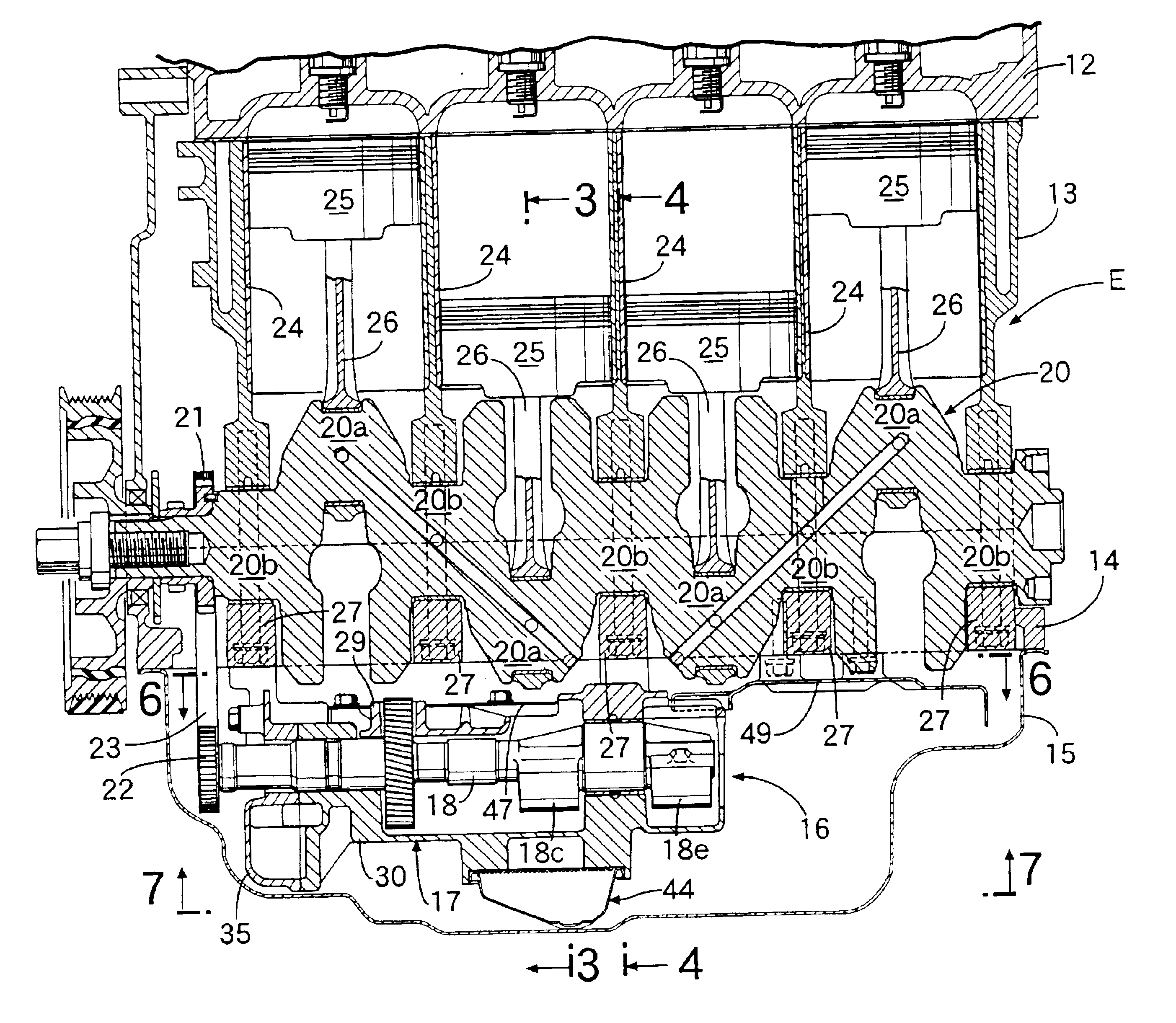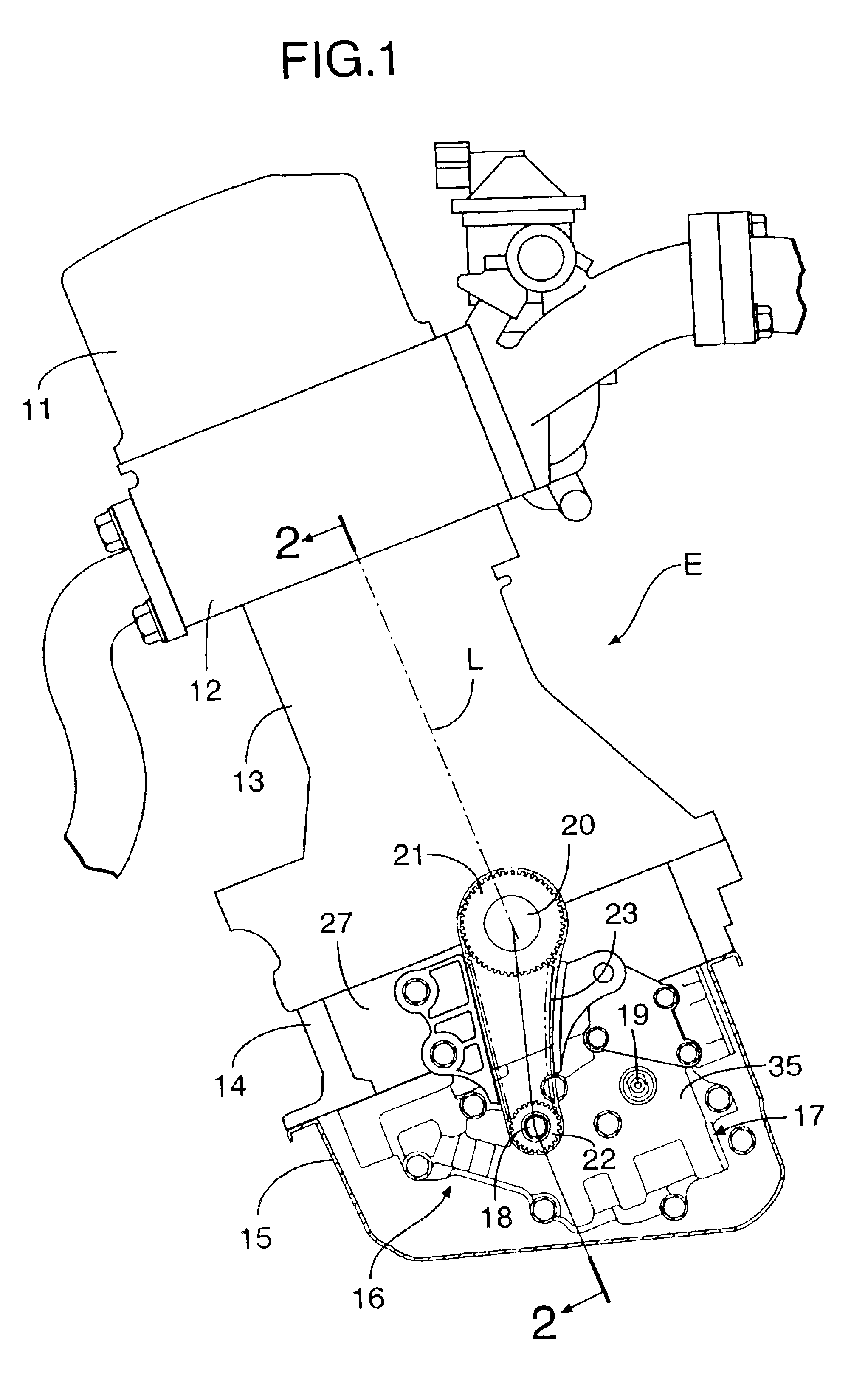Balancer device for engine
a technology for balancers and engines, applied in mechanical equipment, machines/engines, auxillary lubrication, etc., can solve the problems of increasing the number of parts and the number of assembly steps, and achieve the effect of reliably supporting the balancer shaft and increasing the rigidity of the balancer housing
- Summary
- Abstract
- Description
- Claims
- Application Information
AI Technical Summary
Benefits of technology
Problems solved by technology
Method used
Image
Examples
first embodiment
[0047]The present invention will now be described by way of the first embodiment with reference to FIGS. 1 to 12.
[0048]As shown in FIG. 1, the contour of an in-line 4-cylinder engine E for a vehicle is formed by disposing a head cover 11, a cylinder head 12, a cylinder block 13, a lower block 14 and an oil pan 15 in the named order from top to bottom. A cylinder axis L is inclined toward an exhaust side (leftwards as viewed in FIG. 1) with respect to a vertical direction. A secondary balancer device 16 fixed to a lower surface of the lower block 14 and accommodated in the oil pan 15 includes a driving balancer shaft 18 and a follower balancer shaft 19 supported in a balancer housing 17. A sprocket 21 mounted at an end of a crankshaft 20 supported between the cylinder block 13 and the lower block 14 and a sprocket 22 mounted at an end of the driving balancer shaft 18 are connected to each other by an endless chain 23.
[0049]As shown in FIGS. 2 to 5, four pistons slidably received in f...
second embodiment
[0066]the present invention will now be described with reference to FIG. 13.
[0067]In the second embodiment, a first baffle plate 47 and a second baffle plate 48 of the first embodiment are integrally connected to each other by a connection 51 to form a single angular U-shaped baffle plate 52, leading to a reduction in the number of parts. The shapes and functions of the first baffle plate 47 and the second baffle plate 48 are the same as in the first embodiment.
[0068]In the first embodiment shown in FIG. 6, a clearance γ (see FIGS. 6 and 7) is provided between the end edge of the angular U-shaped notch 49c in the third baffle plate 49 and the end edge of the balancer housing 17, but if the end edge of the angular U-shaped notch 49c in the third baffle plate 49 is overlapped on the end edge of the balancer housing 17 by a distance δ, the oil from above the third baffle plate 49 can be prevented from entering the balancer housing through the openings 17a and 17b provided in the end of...
third embodiment
[0069]the present invention will now be described with reference to FIG. 14.
[0070]In the first embodiment of the present invention shown in FIG. 6, the angular U-shaped notch 49c is defined between the pair of cover portions 49a and 49b of the third baffle plate 49, but in the third embodiment, a pair of bores 49d, 49d is defined between the cover portions 49a and 49b and opposed to a pair of openings 29d, 29d which the second balancer weights 18e and 19e face. With the third embodiment, the bores 49d, 49d exhibit the same function as that of the notch 49c in the first embodiment, whereby the rigidity of the cover portions 49a and 49b can be increased by T-shaped connecting walls 49e and 49f surrounding the bores 49d, 49d to inhibit the generation of the vibration further effectively, while reducing the weight of the third baffle plate 49 and reducing the vertical dimension of the engine E.
PUM
 Login to View More
Login to View More Abstract
Description
Claims
Application Information
 Login to View More
Login to View More - R&D
- Intellectual Property
- Life Sciences
- Materials
- Tech Scout
- Unparalleled Data Quality
- Higher Quality Content
- 60% Fewer Hallucinations
Browse by: Latest US Patents, China's latest patents, Technical Efficacy Thesaurus, Application Domain, Technology Topic, Popular Technical Reports.
© 2025 PatSnap. All rights reserved.Legal|Privacy policy|Modern Slavery Act Transparency Statement|Sitemap|About US| Contact US: help@patsnap.com



